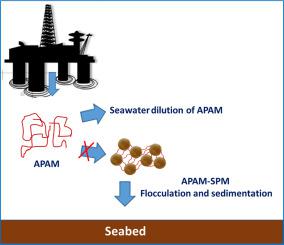Science of the Total Environment ( IF 8.2 ) Pub Date : 2020-12-03 , DOI: 10.1016/j.scitotenv.2020.143888 Odd Gunnar Brakstad , Dag Altin , Marianne Aas , Jørgen Skancke , Trond Nordtug , Julia Farkas

|
Polymer injection is used in enhanced oil recovery (EOR) when an oil field ages and the pressure in the reservoir decreases, or for oil fields with heavy oil. By polymer injection, the viscosity of the water injected for pressure support is increased by mixing with a high concentration polymer solution. Polymers used in EOR operations are often high molecular weight polyacrylamides, including anionic polyacrylamide (APAM), which may enter the marine environment with produced water releases. Since seawater (SW) contains low concentrations of mineral particles (MPs), and polymers like APAM are known to flocculate MPs, we investigated if APAM at different concentrations (0.5 – 10 mg/L) would attach and flocculate MPs, when these occurred in concentrations relevant for oceanic SW (1 mg/L). Two types of MPs, diatomaceous earth and kaolin, were exposed to fluorescence-tagged APAM (APAM-TAG). A low-energy carousel system with natural seawater (SW) was used for incubation of MPs and APAM-TAG at a temperature relevant for the Norwegian Continental Shelf (13°C). Attachment to MPs and aggregates of these were analysed by fluorometry and fluorescence microscopy. Particle analyses showed that only minor fractions of the MPs aggregated. When samples were separated in steel filter with a mesh size of 20μm, the polymer was mainly measured in the flow-through fraction (<20 μm), and the results therefore showed that the APAM mainly remained in the water-phase, or was attached to small particles (<20 μm). For the small fraction of APAM attaching to aggregated MPs, APAM attraction to kaolin was higher than to diatomaceous earth, and fluorescence microscopy analyses confirmed the presence of fluorescent particles at the higher APAM concentrations. MPs at concentrations relevant for oceanic SW are therefore not expected to significantly contribute to sedimentation of APAM dissolved in the water column.
中文翻译:

APAM对海水中矿物质颗粒的附着
当油田老化且储层中的压力降低时,或对于含重油的油田,聚合物注入可用于提高采油率(EOR)。通过聚合物注入,通过与高浓度聚合物溶液混合而增加了为支持压力而注入的水的粘度。在EOR操作中使用的聚合物通常是高分子量聚丙烯酰胺,包括阴离子聚丙烯酰胺(APAM),它们可能随着释放的水进入海洋环境。由于海水(SW)含有低浓度的矿物质颗粒(MPs),并且已知诸如APAM之类的聚合物会絮凝MPs,因此我们研究了当MPAM发生在不同浓度(0.5 – 10 mg / L)时APAM是否会附着并絮凝MPs。与海洋SW有关的浓度(1 mg / L)。MP的两种类型,硅藻土和高岭土,暴露于荧光标记的APAM(APAM-TAG)。将低能量旋转木马系统和天然海水(SW)用于在与挪威大陆架相关的温度(13°C)下孵育MP和APAM-TAG。通过荧光法和荧光显微镜分析对MP的附着及其聚集。颗粒分析表明,只有少量的MP聚集。当样品在筛孔尺寸为20μm的钢过滤器中分离时,主要测量的是流过分数(<20μm),因此,结果表明APAM主要残留在水相中或附着在水相上到小颗粒(<20μm)。对于附着在聚集MP上的一小部分APAM,APAM对高岭土的吸引力高于对硅藻土的吸引力,荧光显微镜分析证实了APAM浓度较高时荧光颗粒的存在。因此,与海洋SW有关的MP预计不会显着促进溶解在水柱中的APAM的沉降。











































 京公网安备 11010802027423号
京公网安备 11010802027423号